Strategic Human Resource Management Analysis: IBM Case Study
VerifiedAdded on 2022/09/17
|25
|6351
|25
Report
AI Summary
This report provides a comprehensive analysis of IBM's human resource management (HRM) practices. It begins with an organizational analysis, detailing the company's background, industry context, strategic approach, and specific HR practices. The report then delves into a VRIN analysis, assessing the value, rarity, imitability, and organization of IBM's resources and capabilities. An environmental analysis follows, examining both hard and soft changes in the business environment, the application of the Harvard model of change analysis, and the impact of major changes on the company. Furthermore, the report evaluates new HR practices using a life cycle model analysis. The report concludes with a discussion of the key findings and insights into IBM's HRM strategies.
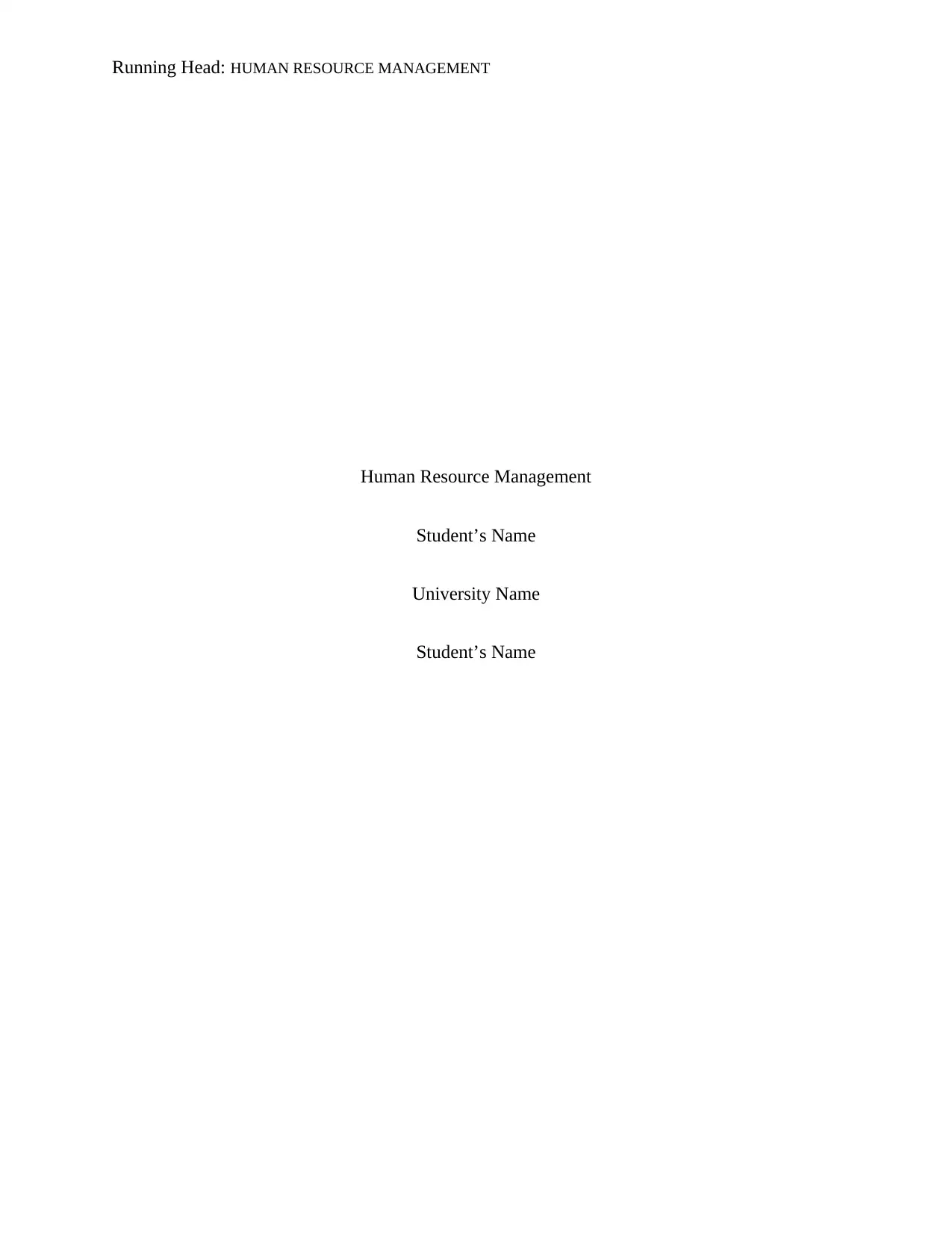
Running Head: HUMAN RESOURCE MANAGEMENT
Human Resource Management
Student’s Name
University Name
Student’s Name
Human Resource Management
Student’s Name
University Name
Student’s Name
Paraphrase This Document
Need a fresh take? Get an instant paraphrase of this document with our AI Paraphraser
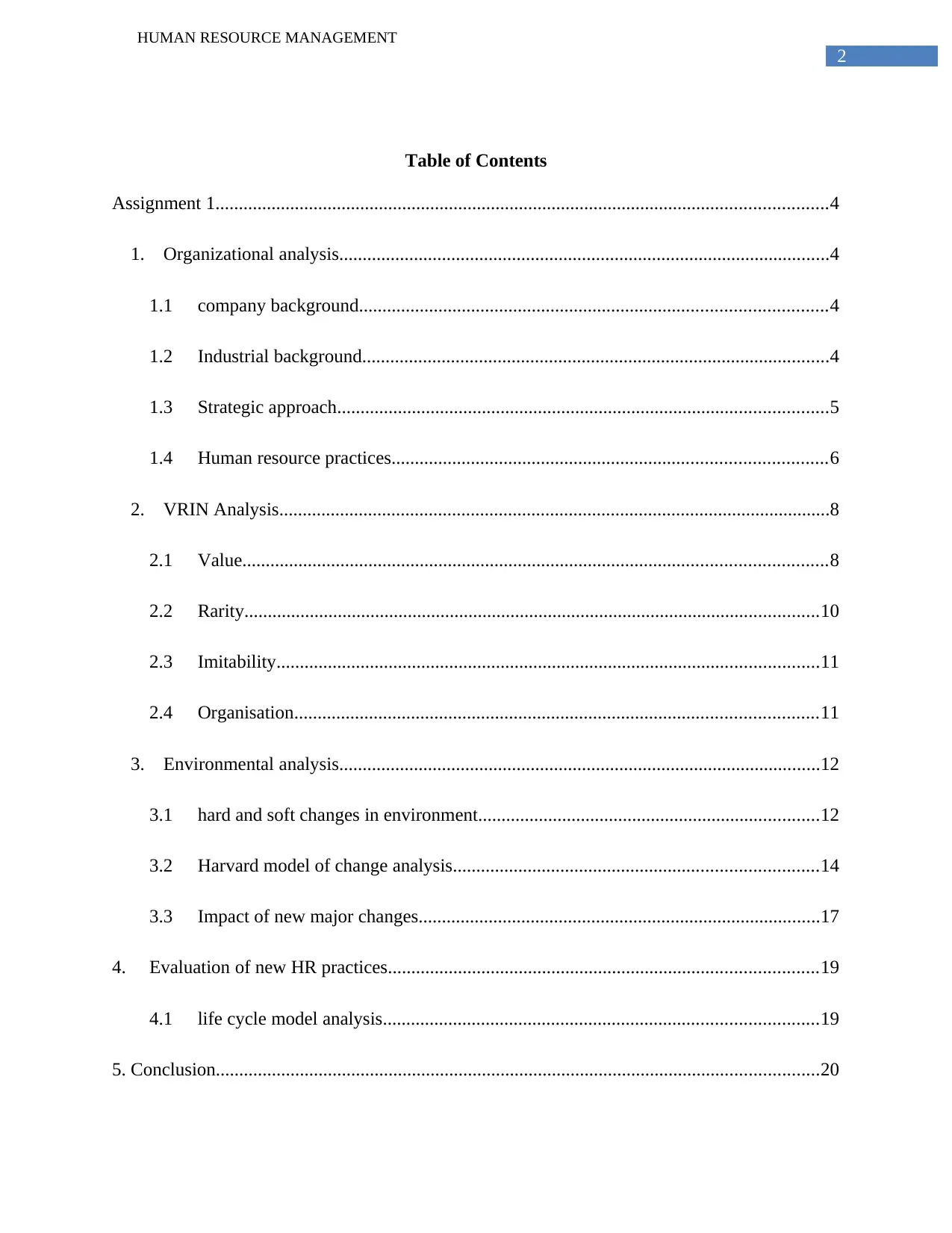
2
HUMAN RESOURCE MANAGEMENT
Table of Contents
Assignment 1...................................................................................................................................4
1. Organizational analysis.........................................................................................................4
1.1 company background....................................................................................................4
1.2 Industrial background....................................................................................................4
1.3 Strategic approach.........................................................................................................5
1.4 Human resource practices.............................................................................................6
2. VRIN Analysis......................................................................................................................8
2.1 Value.............................................................................................................................8
2.2 Rarity...........................................................................................................................10
2.3 Imitability....................................................................................................................11
2.4 Organisation................................................................................................................11
3. Environmental analysis.......................................................................................................12
3.1 hard and soft changes in environment.........................................................................12
3.2 Harvard model of change analysis..............................................................................14
3.3 Impact of new major changes......................................................................................17
4. Evaluation of new HR practices............................................................................................19
4.1 life cycle model analysis.............................................................................................19
5. Conclusion.................................................................................................................................20
HUMAN RESOURCE MANAGEMENT
Table of Contents
Assignment 1...................................................................................................................................4
1. Organizational analysis.........................................................................................................4
1.1 company background....................................................................................................4
1.2 Industrial background....................................................................................................4
1.3 Strategic approach.........................................................................................................5
1.4 Human resource practices.............................................................................................6
2. VRIN Analysis......................................................................................................................8
2.1 Value.............................................................................................................................8
2.2 Rarity...........................................................................................................................10
2.3 Imitability....................................................................................................................11
2.4 Organisation................................................................................................................11
3. Environmental analysis.......................................................................................................12
3.1 hard and soft changes in environment.........................................................................12
3.2 Harvard model of change analysis..............................................................................14
3.3 Impact of new major changes......................................................................................17
4. Evaluation of new HR practices............................................................................................19
4.1 life cycle model analysis.............................................................................................19
5. Conclusion.................................................................................................................................20
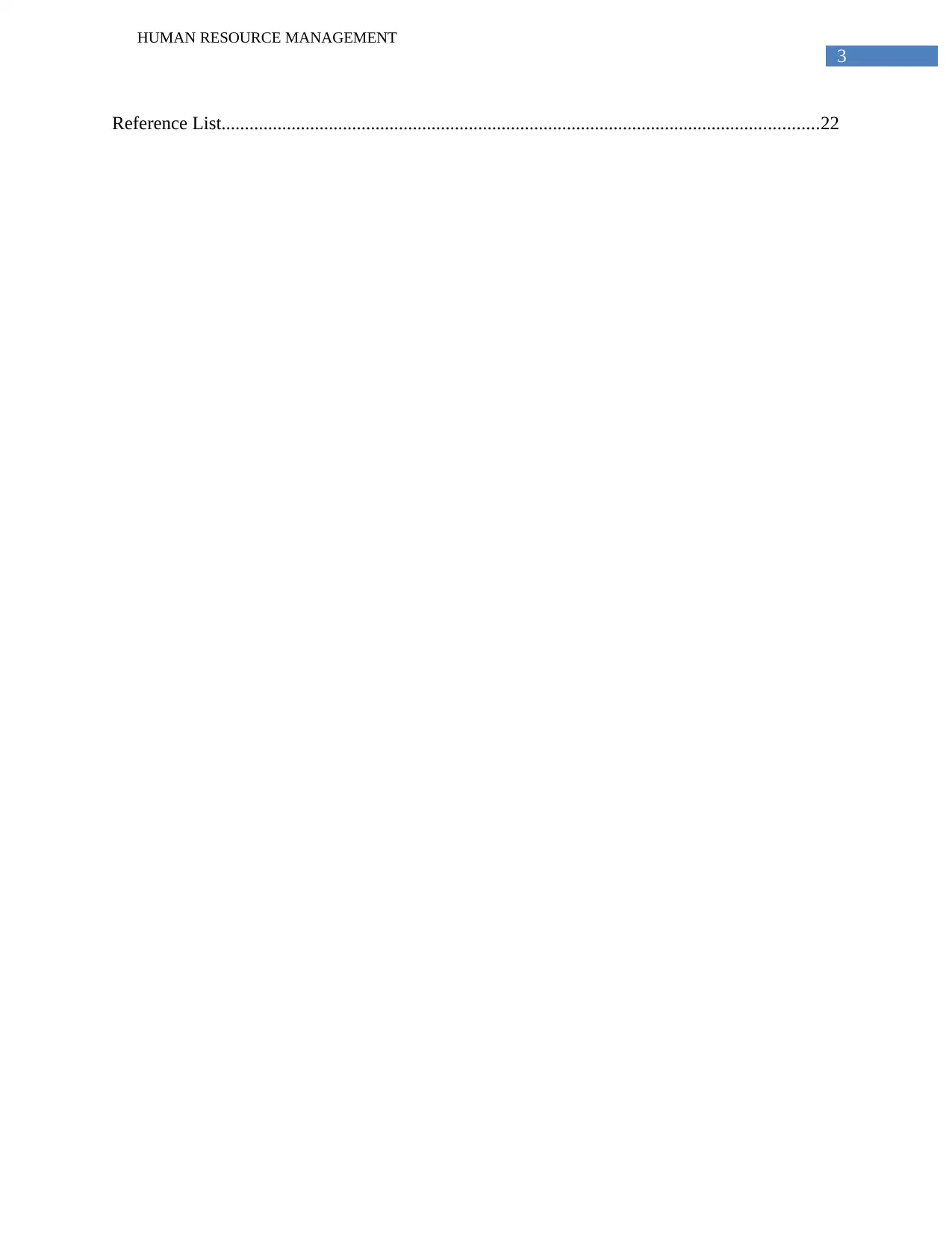
3
HUMAN RESOURCE MANAGEMENT
Reference List................................................................................................................................22
HUMAN RESOURCE MANAGEMENT
Reference List................................................................................................................................22
⊘ This is a preview!⊘
Do you want full access?
Subscribe today to unlock all pages.

Trusted by 1+ million students worldwide
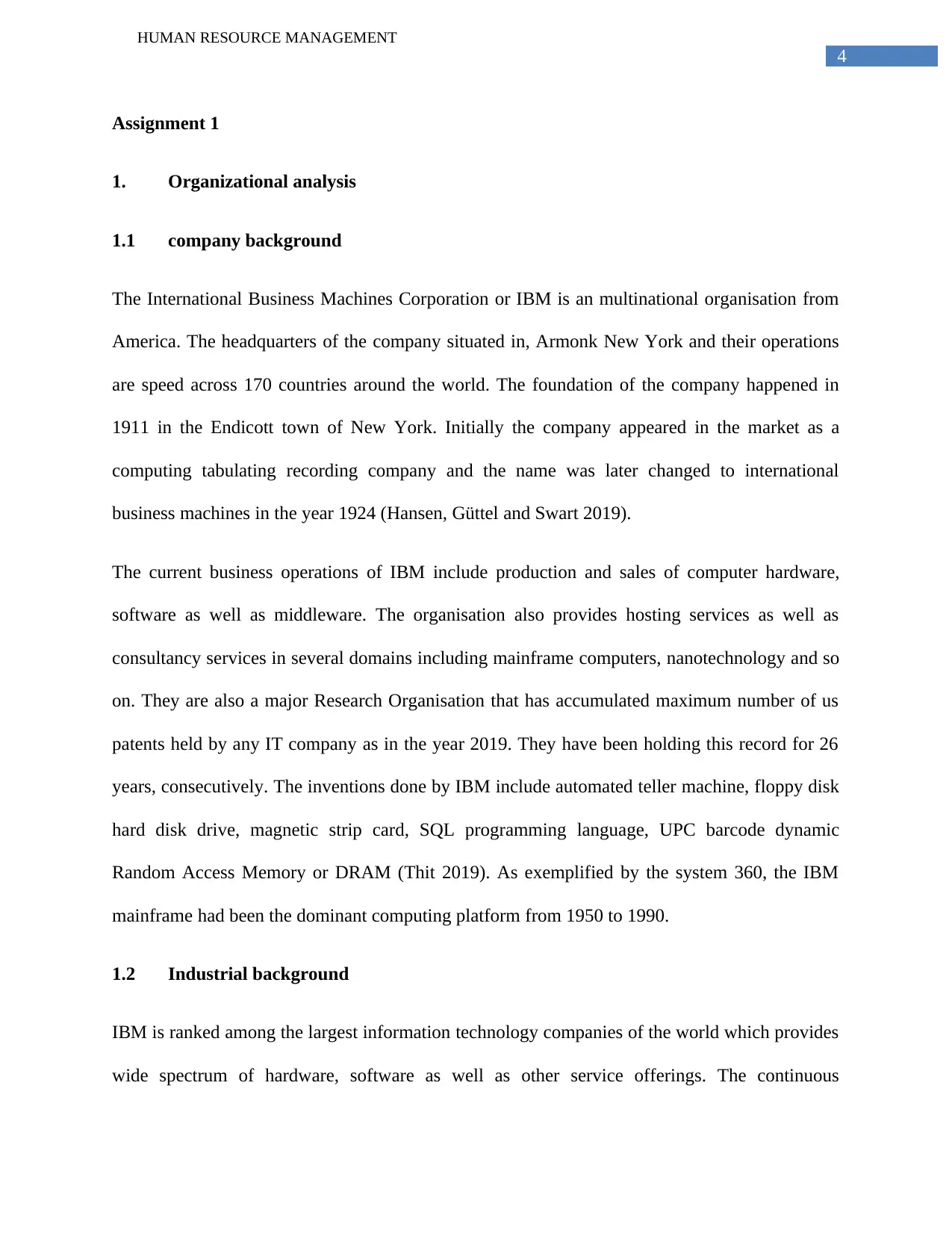
4
HUMAN RESOURCE MANAGEMENT
Assignment 1
1. Organizational analysis
1.1 company background
The International Business Machines Corporation or IBM is an multinational organisation from
America. The headquarters of the company situated in, Armonk New York and their operations
are speed across 170 countries around the world. The foundation of the company happened in
1911 in the Endicott town of New York. Initially the company appeared in the market as a
computing tabulating recording company and the name was later changed to international
business machines in the year 1924 (Hansen, Güttel and Swart 2019).
The current business operations of IBM include production and sales of computer hardware,
software as well as middleware. The organisation also provides hosting services as well as
consultancy services in several domains including mainframe computers, nanotechnology and so
on. They are also a major Research Organisation that has accumulated maximum number of us
patents held by any IT company as in the year 2019. They have been holding this record for 26
years, consecutively. The inventions done by IBM include automated teller machine, floppy disk
hard disk drive, magnetic strip card, SQL programming language, UPC barcode dynamic
Random Access Memory or DRAM (Thit 2019). As exemplified by the system 360, the IBM
mainframe had been the dominant computing platform from 1950 to 1990.
1.2 Industrial background
IBM is ranked among the largest information technology companies of the world which provides
wide spectrum of hardware, software as well as other service offerings. The continuous
HUMAN RESOURCE MANAGEMENT
Assignment 1
1. Organizational analysis
1.1 company background
The International Business Machines Corporation or IBM is an multinational organisation from
America. The headquarters of the company situated in, Armonk New York and their operations
are speed across 170 countries around the world. The foundation of the company happened in
1911 in the Endicott town of New York. Initially the company appeared in the market as a
computing tabulating recording company and the name was later changed to international
business machines in the year 1924 (Hansen, Güttel and Swart 2019).
The current business operations of IBM include production and sales of computer hardware,
software as well as middleware. The organisation also provides hosting services as well as
consultancy services in several domains including mainframe computers, nanotechnology and so
on. They are also a major Research Organisation that has accumulated maximum number of us
patents held by any IT company as in the year 2019. They have been holding this record for 26
years, consecutively. The inventions done by IBM include automated teller machine, floppy disk
hard disk drive, magnetic strip card, SQL programming language, UPC barcode dynamic
Random Access Memory or DRAM (Thit 2019). As exemplified by the system 360, the IBM
mainframe had been the dominant computing platform from 1950 to 1990.
1.2 Industrial background
IBM is ranked among the largest information technology companies of the world which provides
wide spectrum of hardware, software as well as other service offerings. The continuous
Paraphrase This Document
Need a fresh take? Get an instant paraphrase of this document with our AI Paraphraser
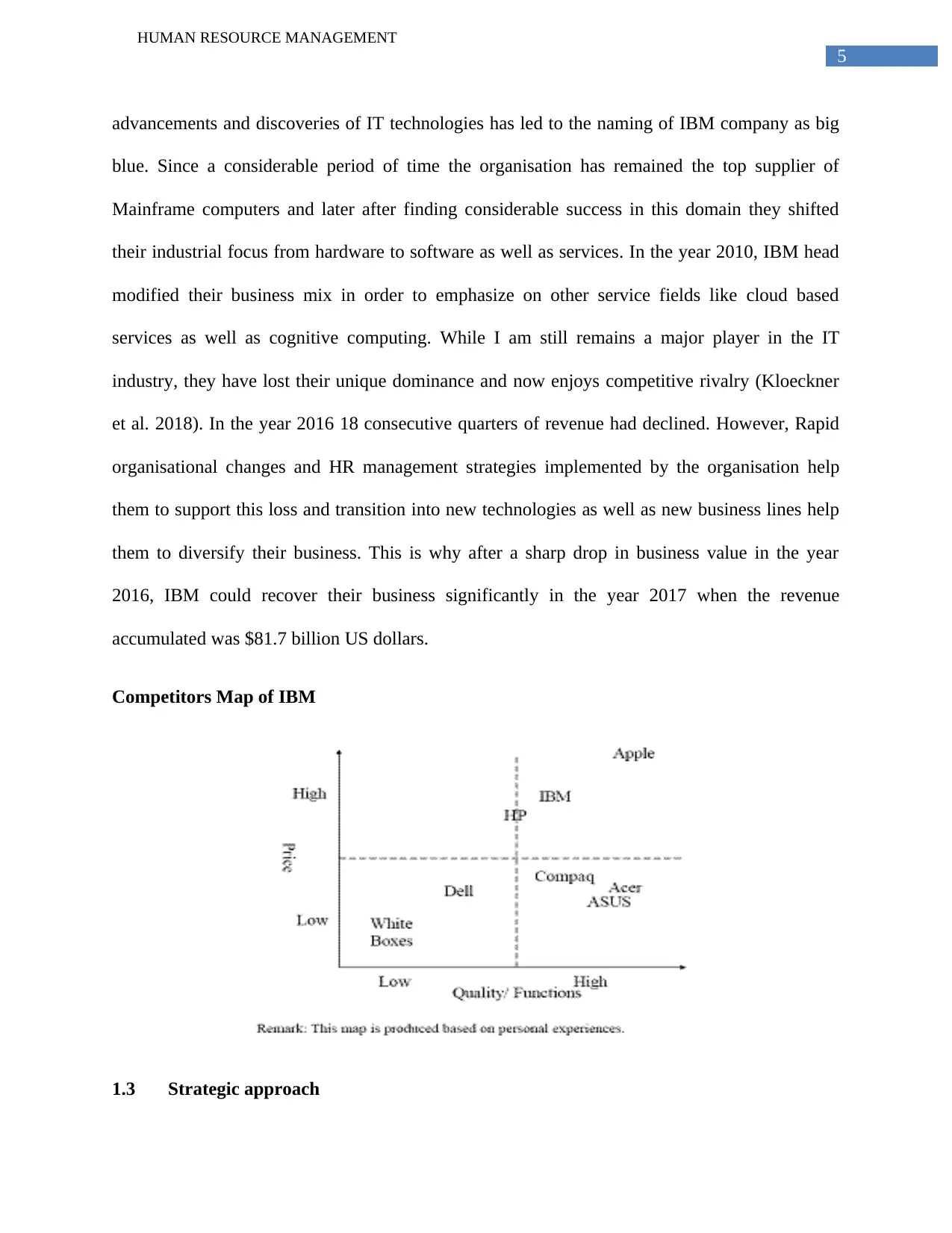
5
HUMAN RESOURCE MANAGEMENT
advancements and discoveries of IT technologies has led to the naming of IBM company as big
blue. Since a considerable period of time the organisation has remained the top supplier of
Mainframe computers and later after finding considerable success in this domain they shifted
their industrial focus from hardware to software as well as services. In the year 2010, IBM head
modified their business mix in order to emphasize on other service fields like cloud based
services as well as cognitive computing. While I am still remains a major player in the IT
industry, they have lost their unique dominance and now enjoys competitive rivalry (Kloeckner
et al. 2018). In the year 2016 18 consecutive quarters of revenue had declined. However, Rapid
organisational changes and HR management strategies implemented by the organisation help
them to support this loss and transition into new technologies as well as new business lines help
them to diversify their business. This is why after a sharp drop in business value in the year
2016, IBM could recover their business significantly in the year 2017 when the revenue
accumulated was $81.7 billion US dollars.
Competitors Map of IBM
1.3 Strategic approach
HUMAN RESOURCE MANAGEMENT
advancements and discoveries of IT technologies has led to the naming of IBM company as big
blue. Since a considerable period of time the organisation has remained the top supplier of
Mainframe computers and later after finding considerable success in this domain they shifted
their industrial focus from hardware to software as well as services. In the year 2010, IBM head
modified their business mix in order to emphasize on other service fields like cloud based
services as well as cognitive computing. While I am still remains a major player in the IT
industry, they have lost their unique dominance and now enjoys competitive rivalry (Kloeckner
et al. 2018). In the year 2016 18 consecutive quarters of revenue had declined. However, Rapid
organisational changes and HR management strategies implemented by the organisation help
them to support this loss and transition into new technologies as well as new business lines help
them to diversify their business. This is why after a sharp drop in business value in the year
2016, IBM could recover their business significantly in the year 2017 when the revenue
accumulated was $81.7 billion US dollars.
Competitors Map of IBM
1.3 Strategic approach

6
HUMAN RESOURCE MANAGEMENT
The main strategic approach that needs discussion here is the transition of the organization when
they decided to transform their business into software and other services from mainframe
computing. During this transition phase the CEO had observed that analysis of the behavior of
the employees as well as customers of the organization would be necessary for interpretation of
the inherent strength of the company. However in doing so, the company accounted for severe
losses. The huge strategic debate that IBM phased was whether to keep the company on board or
in order to save it from eventual bankruptcy and massive disaster, break it into smaller
organisations with manageable units (Azeem and Yasmin, 2018). Nevertheless, both the former
and the current CEO had favoured not to make the business conversation by dividing it into
various units and considering from the customers perspective, it was also highlight it that we
preferred a one stop shop for all sorts of services. Most of the essential clients of IBM are the big
business forms required several kind of IT services. It would have been impossible for the
smaller companies, had IBM been split, to Cater to the business needs of potential clients.
1.4 Human resource practices
Human resource Strategies and practices are closely associated with the organisational culture.
The sustenance of IBM over hundred years has been accountable to several cultural and
organisational changes that help the organisation to which time the internal and external
pressure. Dramatic technological as well as economic changes were suffered by the organisation
to remain relevant amidst the several IT companies existing today. Nevertheless, as highlighted
by Hull and Nezhad (2016), one of the biggest changes that the organisation went through is not
regarding the computing Technology changed, but it is about the cultural change that IBM had
implemented from time to time. Speaking about the last decade it has been realised that IBM is
realigning their agent practices as well as strategies so that they can substantially change from
HUMAN RESOURCE MANAGEMENT
The main strategic approach that needs discussion here is the transition of the organization when
they decided to transform their business into software and other services from mainframe
computing. During this transition phase the CEO had observed that analysis of the behavior of
the employees as well as customers of the organization would be necessary for interpretation of
the inherent strength of the company. However in doing so, the company accounted for severe
losses. The huge strategic debate that IBM phased was whether to keep the company on board or
in order to save it from eventual bankruptcy and massive disaster, break it into smaller
organisations with manageable units (Azeem and Yasmin, 2018). Nevertheless, both the former
and the current CEO had favoured not to make the business conversation by dividing it into
various units and considering from the customers perspective, it was also highlight it that we
preferred a one stop shop for all sorts of services. Most of the essential clients of IBM are the big
business forms required several kind of IT services. It would have been impossible for the
smaller companies, had IBM been split, to Cater to the business needs of potential clients.
1.4 Human resource practices
Human resource Strategies and practices are closely associated with the organisational culture.
The sustenance of IBM over hundred years has been accountable to several cultural and
organisational changes that help the organisation to which time the internal and external
pressure. Dramatic technological as well as economic changes were suffered by the organisation
to remain relevant amidst the several IT companies existing today. Nevertheless, as highlighted
by Hull and Nezhad (2016), one of the biggest changes that the organisation went through is not
regarding the computing Technology changed, but it is about the cultural change that IBM had
implemented from time to time. Speaking about the last decade it has been realised that IBM is
realigning their agent practices as well as strategies so that they can substantially change from
⊘ This is a preview!⊘
Do you want full access?
Subscribe today to unlock all pages.

Trusted by 1+ million students worldwide
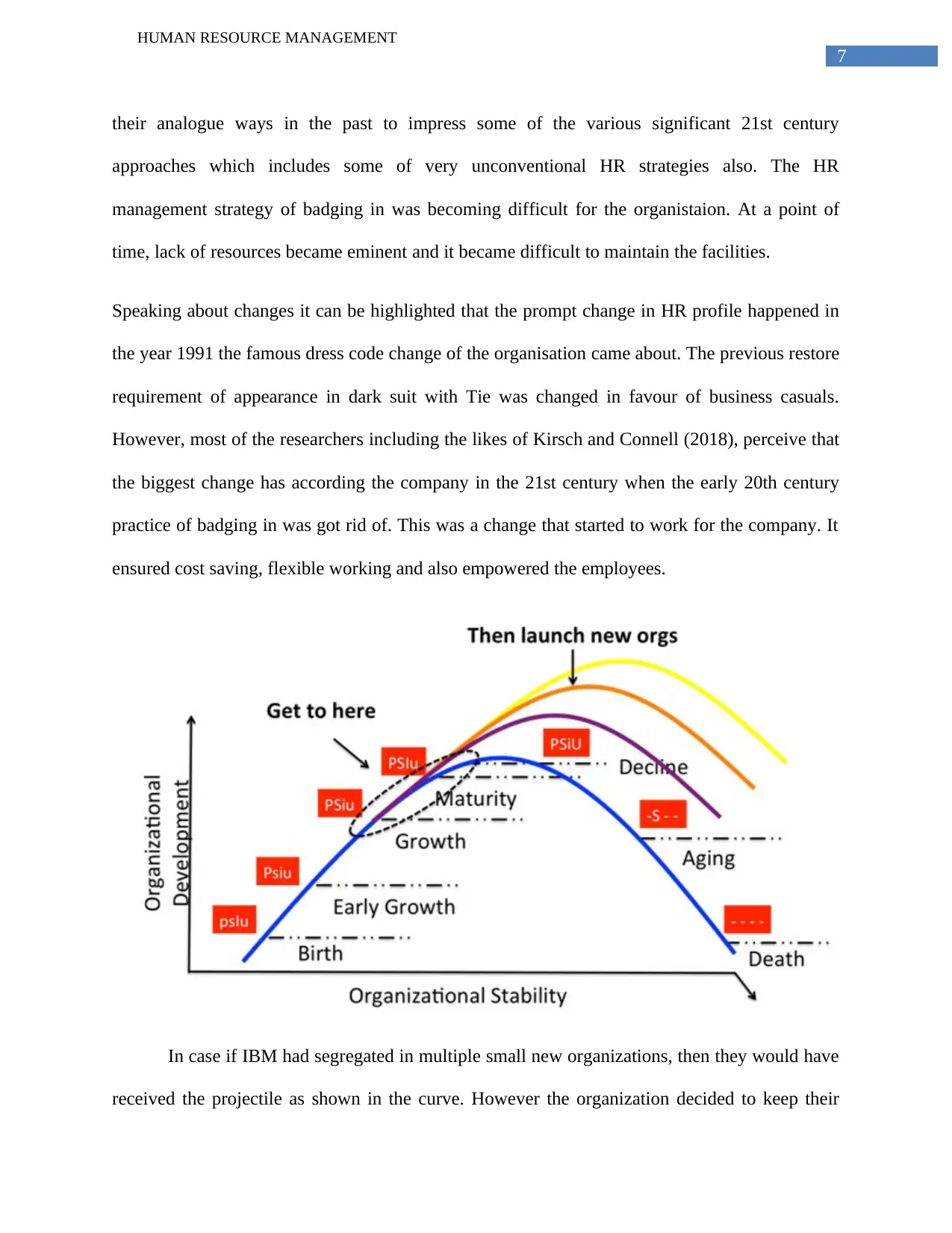
7
HUMAN RESOURCE MANAGEMENT
their analogue ways in the past to impress some of the various significant 21st century
approaches which includes some of very unconventional HR strategies also. The HR
management strategy of badging in was becoming difficult for the organistaion. At a point of
time, lack of resources became eminent and it became difficult to maintain the facilities.
Speaking about changes it can be highlighted that the prompt change in HR profile happened in
the year 1991 the famous dress code change of the organisation came about. The previous restore
requirement of appearance in dark suit with Tie was changed in favour of business casuals.
However, most of the researchers including the likes of Kirsch and Connell (2018), perceive that
the biggest change has according the company in the 21st century when the early 20th century
practice of badging in was got rid of. This was a change that started to work for the company. It
ensured cost saving, flexible working and also empowered the employees.
In case if IBM had segregated in multiple small new organizations, then they would have
received the projectile as shown in the curve. However the organization decided to keep their
HUMAN RESOURCE MANAGEMENT
their analogue ways in the past to impress some of the various significant 21st century
approaches which includes some of very unconventional HR strategies also. The HR
management strategy of badging in was becoming difficult for the organistaion. At a point of
time, lack of resources became eminent and it became difficult to maintain the facilities.
Speaking about changes it can be highlighted that the prompt change in HR profile happened in
the year 1991 the famous dress code change of the organisation came about. The previous restore
requirement of appearance in dark suit with Tie was changed in favour of business casuals.
However, most of the researchers including the likes of Kirsch and Connell (2018), perceive that
the biggest change has according the company in the 21st century when the early 20th century
practice of badging in was got rid of. This was a change that started to work for the company. It
ensured cost saving, flexible working and also empowered the employees.
In case if IBM had segregated in multiple small new organizations, then they would have
received the projectile as shown in the curve. However the organization decided to keep their
Paraphrase This Document
Need a fresh take? Get an instant paraphrase of this document with our AI Paraphraser
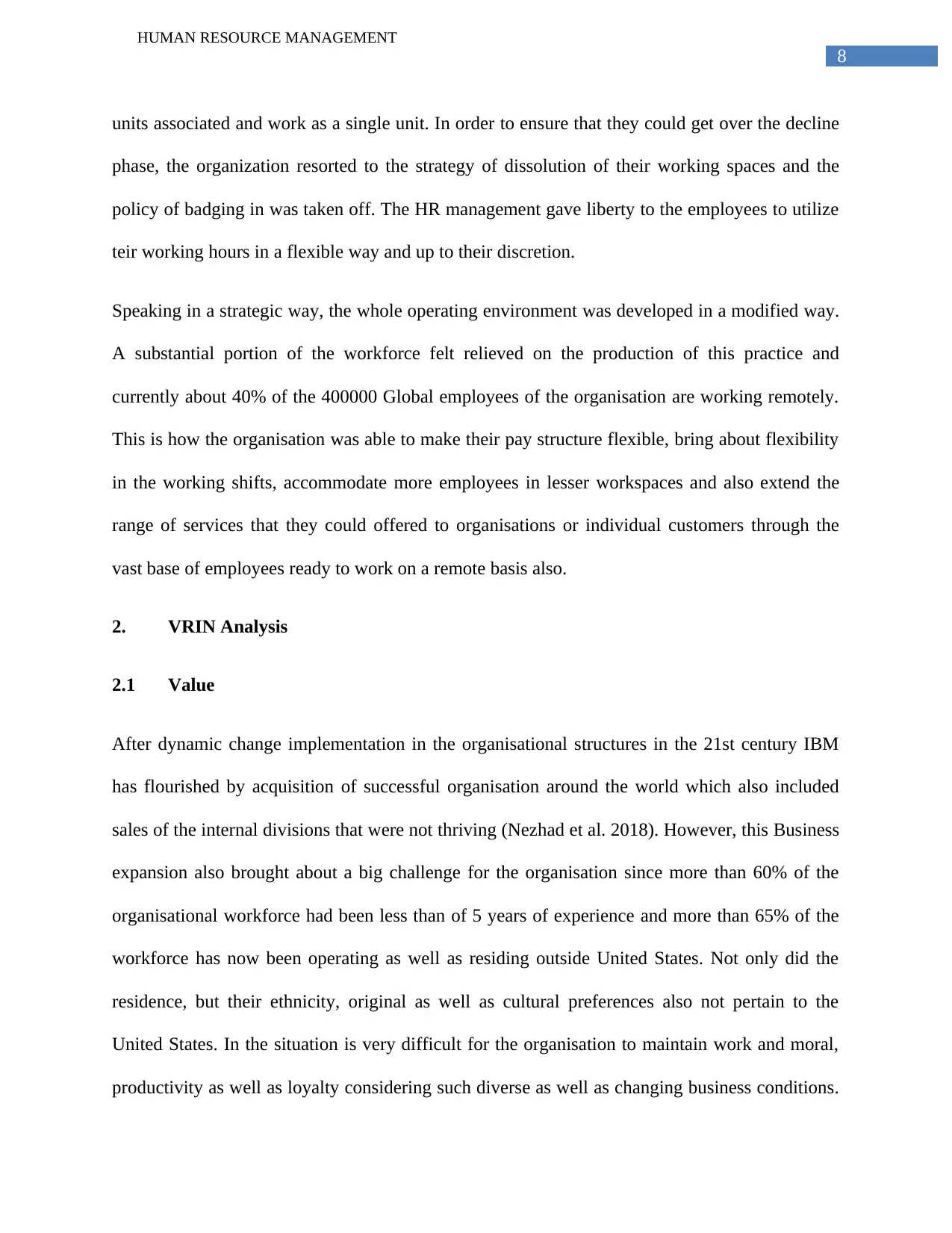
8
HUMAN RESOURCE MANAGEMENT
units associated and work as a single unit. In order to ensure that they could get over the decline
phase, the organization resorted to the strategy of dissolution of their working spaces and the
policy of badging in was taken off. The HR management gave liberty to the employees to utilize
teir working hours in a flexible way and up to their discretion.
Speaking in a strategic way, the whole operating environment was developed in a modified way.
A substantial portion of the workforce felt relieved on the production of this practice and
currently about 40% of the 400000 Global employees of the organisation are working remotely.
This is how the organisation was able to make their pay structure flexible, bring about flexibility
in the working shifts, accommodate more employees in lesser workspaces and also extend the
range of services that they could offered to organisations or individual customers through the
vast base of employees ready to work on a remote basis also.
2. VRIN Analysis
2.1 Value
After dynamic change implementation in the organisational structures in the 21st century IBM
has flourished by acquisition of successful organisation around the world which also included
sales of the internal divisions that were not thriving (Nezhad et al. 2018). However, this Business
expansion also brought about a big challenge for the organisation since more than 60% of the
organisational workforce had been less than of 5 years of experience and more than 65% of the
workforce has now been operating as well as residing outside United States. Not only did the
residence, but their ethnicity, original as well as cultural preferences also not pertain to the
United States. In the situation is very difficult for the organisation to maintain work and moral,
productivity as well as loyalty considering such diverse as well as changing business conditions.
HUMAN RESOURCE MANAGEMENT
units associated and work as a single unit. In order to ensure that they could get over the decline
phase, the organization resorted to the strategy of dissolution of their working spaces and the
policy of badging in was taken off. The HR management gave liberty to the employees to utilize
teir working hours in a flexible way and up to their discretion.
Speaking in a strategic way, the whole operating environment was developed in a modified way.
A substantial portion of the workforce felt relieved on the production of this practice and
currently about 40% of the 400000 Global employees of the organisation are working remotely.
This is how the organisation was able to make their pay structure flexible, bring about flexibility
in the working shifts, accommodate more employees in lesser workspaces and also extend the
range of services that they could offered to organisations or individual customers through the
vast base of employees ready to work on a remote basis also.
2. VRIN Analysis
2.1 Value
After dynamic change implementation in the organisational structures in the 21st century IBM
has flourished by acquisition of successful organisation around the world which also included
sales of the internal divisions that were not thriving (Nezhad et al. 2018). However, this Business
expansion also brought about a big challenge for the organisation since more than 60% of the
organisational workforce had been less than of 5 years of experience and more than 65% of the
workforce has now been operating as well as residing outside United States. Not only did the
residence, but their ethnicity, original as well as cultural preferences also not pertain to the
United States. In the situation is very difficult for the organisation to maintain work and moral,
productivity as well as loyalty considering such diverse as well as changing business conditions.

9
HUMAN RESOURCE MANAGEMENT
Nevertheless, the strategic change of Human Resource Management implemented in IBM had
the intention of changing this atmosphere into a resource will business opportunity through the
introduction of 4 directive components in human resources management.
In the first place, the organisation emphasize on providing equitable benefits of all employees, in
all countries, regardless of their race, sexual preference, ethnicity or gender. The organisation
also extended the same-sex partner benefits to the Employees which help the organisation to
100% rating from the human rights campaigns and the international women labour groups also
provided similarly high ratings to the organisation. This also help to develop the brand
Awareness of the organisation in various countries because of which it becomes easier for them
to get hold of high potential candidates which was needed for massive recruitment of IBM in
several countries
Secondly, the annual Global pulse survey had gadget data from more than 40% of the employees
of IBM, every year in the last decade in order to analyse on the workplace conditions as well as
issues. In fact data survey was carried on to analyse the community conditions of the IBM
workers. It was found that the company had been emphasizing and rewarding volunteer work in
the communities emphasize at ensuring that the employees of the company are living in dignified
standards and communities (Lengnick-Hall, Lengnick-Hall and McIver 2019).
The third change in the organisation was a massive one where the management decided that not
only the executive but also the employees of the lower hierarchical order would be eligible for
getting the performance based bonus and the program that was initiated by the organisation for
conveyance of the performance based bonus included employees of all the hierarchical orders.
HUMAN RESOURCE MANAGEMENT
Nevertheless, the strategic change of Human Resource Management implemented in IBM had
the intention of changing this atmosphere into a resource will business opportunity through the
introduction of 4 directive components in human resources management.
In the first place, the organisation emphasize on providing equitable benefits of all employees, in
all countries, regardless of their race, sexual preference, ethnicity or gender. The organisation
also extended the same-sex partner benefits to the Employees which help the organisation to
100% rating from the human rights campaigns and the international women labour groups also
provided similarly high ratings to the organisation. This also help to develop the brand
Awareness of the organisation in various countries because of which it becomes easier for them
to get hold of high potential candidates which was needed for massive recruitment of IBM in
several countries
Secondly, the annual Global pulse survey had gadget data from more than 40% of the employees
of IBM, every year in the last decade in order to analyse on the workplace conditions as well as
issues. In fact data survey was carried on to analyse the community conditions of the IBM
workers. It was found that the company had been emphasizing and rewarding volunteer work in
the communities emphasize at ensuring that the employees of the company are living in dignified
standards and communities (Lengnick-Hall, Lengnick-Hall and McIver 2019).
The third change in the organisation was a massive one where the management decided that not
only the executive but also the employees of the lower hierarchical order would be eligible for
getting the performance based bonus and the program that was initiated by the organisation for
conveyance of the performance based bonus included employees of all the hierarchical orders.
⊘ This is a preview!⊘
Do you want full access?
Subscribe today to unlock all pages.

Trusted by 1+ million students worldwide

10
HUMAN RESOURCE MANAGEMENT
At last, comes perhaps the most indicative change that highlights the depth of HR management at
IBM. Training had been of Paramount importance in the organisations since the company was
flourishing at such a massive rate and in such diverse business domains. Considering this fact it
can be highlighted that the approximate investment of IBM amounting to about 1700 US dollars
in Behind every employee for training them in the new areas of skill required for further
operations, including the interactive as well as interpersonal skills helped in the foundation of a
very strong base of skilled as well as reputed and experienced employees. Organisation did not
drop of the currently existing base of workers in order to incorporate and employ casual workers
based on their business project. It was rather indicated that the organisation should be retaining
the current employees alongside making new inclusions and recruitment thereby developing an
employee culture of coherence and inclusion. The company could have easily followed the later
business model as it is done by currently emerging Organizations (Anya, Moore and Nezhad,
2017). It was the far reaching approach of the CEO of the organisation, which help the
organisation to realise that a sustainable basis of employees would be very essential in
developing a futuristic workforce who would be able to significantly reflects the organisational
culture and carry forward the business in equal shape and hope.
2.2 Rarity
The rarity in the business of IBM is insured by the fact that the four steps strategies, each of
which are highly unconventional are being followedorganisation, as represented by the unique
HR managerial heads. In consideration to the approaches undertaken in photo contests, it can be
highlighted that it is not possible for all businesses to emphasize equitable benefits for all the
employees irrespective of didi diversification factor, if they do not have a flight planning and
implementation structure as big as IBM. The survey results that helped IBM to understand the
HUMAN RESOURCE MANAGEMENT
At last, comes perhaps the most indicative change that highlights the depth of HR management at
IBM. Training had been of Paramount importance in the organisations since the company was
flourishing at such a massive rate and in such diverse business domains. Considering this fact it
can be highlighted that the approximate investment of IBM amounting to about 1700 US dollars
in Behind every employee for training them in the new areas of skill required for further
operations, including the interactive as well as interpersonal skills helped in the foundation of a
very strong base of skilled as well as reputed and experienced employees. Organisation did not
drop of the currently existing base of workers in order to incorporate and employ casual workers
based on their business project. It was rather indicated that the organisation should be retaining
the current employees alongside making new inclusions and recruitment thereby developing an
employee culture of coherence and inclusion. The company could have easily followed the later
business model as it is done by currently emerging Organizations (Anya, Moore and Nezhad,
2017). It was the far reaching approach of the CEO of the organisation, which help the
organisation to realise that a sustainable basis of employees would be very essential in
developing a futuristic workforce who would be able to significantly reflects the organisational
culture and carry forward the business in equal shape and hope.
2.2 Rarity
The rarity in the business of IBM is insured by the fact that the four steps strategies, each of
which are highly unconventional are being followedorganisation, as represented by the unique
HR managerial heads. In consideration to the approaches undertaken in photo contests, it can be
highlighted that it is not possible for all businesses to emphasize equitable benefits for all the
employees irrespective of didi diversification factor, if they do not have a flight planning and
implementation structure as big as IBM. The survey results that helped IBM to understand the
Paraphrase This Document
Need a fresh take? Get an instant paraphrase of this document with our AI Paraphraser
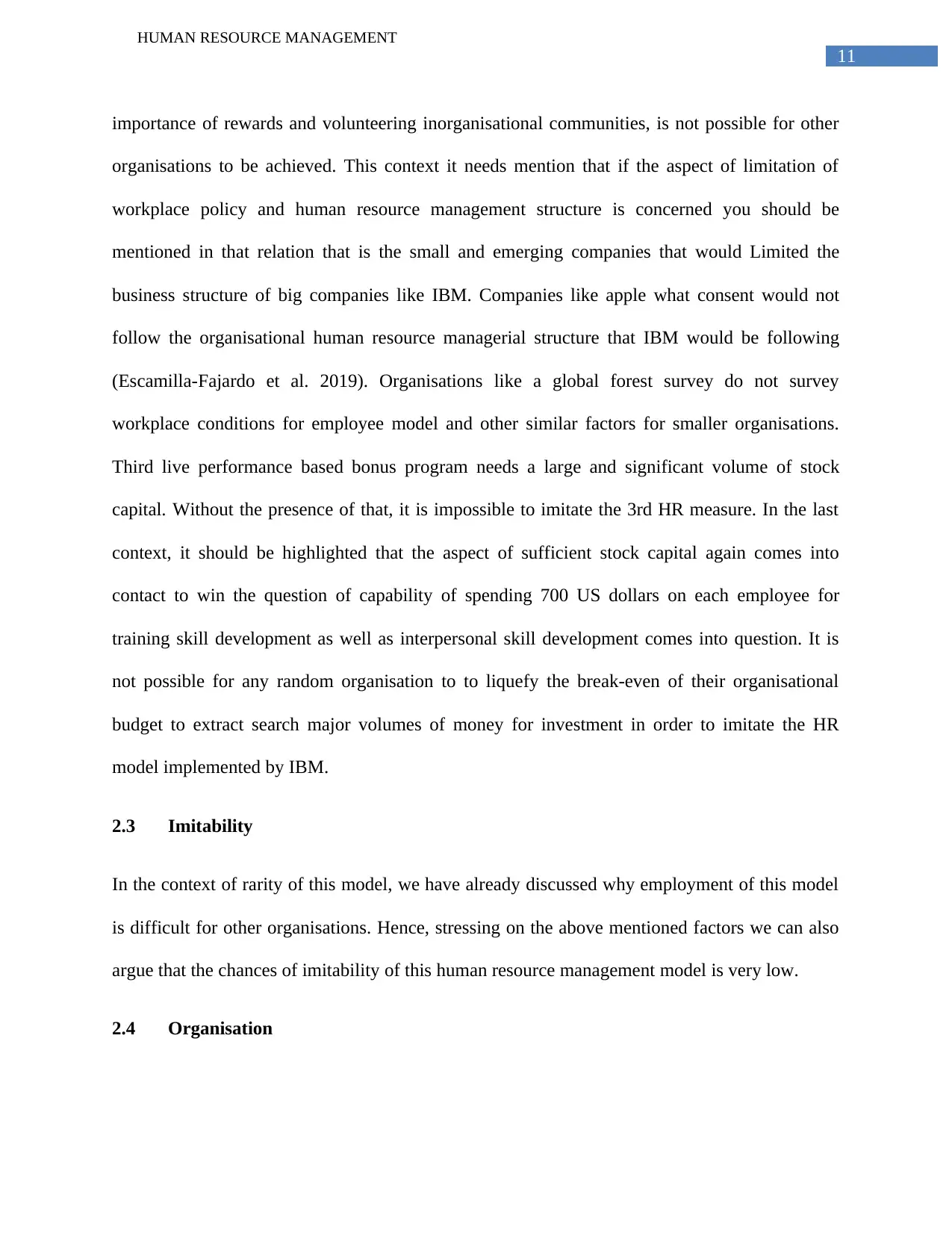
11
HUMAN RESOURCE MANAGEMENT
importance of rewards and volunteering inorganisational communities, is not possible for other
organisations to be achieved. This context it needs mention that if the aspect of limitation of
workplace policy and human resource management structure is concerned you should be
mentioned in that relation that is the small and emerging companies that would Limited the
business structure of big companies like IBM. Companies like apple what consent would not
follow the organisational human resource managerial structure that IBM would be following
(Escamilla-Fajardo et al. 2019). Organisations like a global forest survey do not survey
workplace conditions for employee model and other similar factors for smaller organisations.
Third live performance based bonus program needs a large and significant volume of stock
capital. Without the presence of that, it is impossible to imitate the 3rd HR measure. In the last
context, it should be highlighted that the aspect of sufficient stock capital again comes into
contact to win the question of capability of spending 700 US dollars on each employee for
training skill development as well as interpersonal skill development comes into question. It is
not possible for any random organisation to to liquefy the break-even of their organisational
budget to extract search major volumes of money for investment in order to imitate the HR
model implemented by IBM.
2.3 Imitability
In the context of rarity of this model, we have already discussed why employment of this model
is difficult for other organisations. Hence, stressing on the above mentioned factors we can also
argue that the chances of imitability of this human resource management model is very low.
2.4 Organisation
HUMAN RESOURCE MANAGEMENT
importance of rewards and volunteering inorganisational communities, is not possible for other
organisations to be achieved. This context it needs mention that if the aspect of limitation of
workplace policy and human resource management structure is concerned you should be
mentioned in that relation that is the small and emerging companies that would Limited the
business structure of big companies like IBM. Companies like apple what consent would not
follow the organisational human resource managerial structure that IBM would be following
(Escamilla-Fajardo et al. 2019). Organisations like a global forest survey do not survey
workplace conditions for employee model and other similar factors for smaller organisations.
Third live performance based bonus program needs a large and significant volume of stock
capital. Without the presence of that, it is impossible to imitate the 3rd HR measure. In the last
context, it should be highlighted that the aspect of sufficient stock capital again comes into
contact to win the question of capability of spending 700 US dollars on each employee for
training skill development as well as interpersonal skill development comes into question. It is
not possible for any random organisation to to liquefy the break-even of their organisational
budget to extract search major volumes of money for investment in order to imitate the HR
model implemented by IBM.
2.3 Imitability
In the context of rarity of this model, we have already discussed why employment of this model
is difficult for other organisations. Hence, stressing on the above mentioned factors we can also
argue that the chances of imitability of this human resource management model is very low.
2.4 Organisation
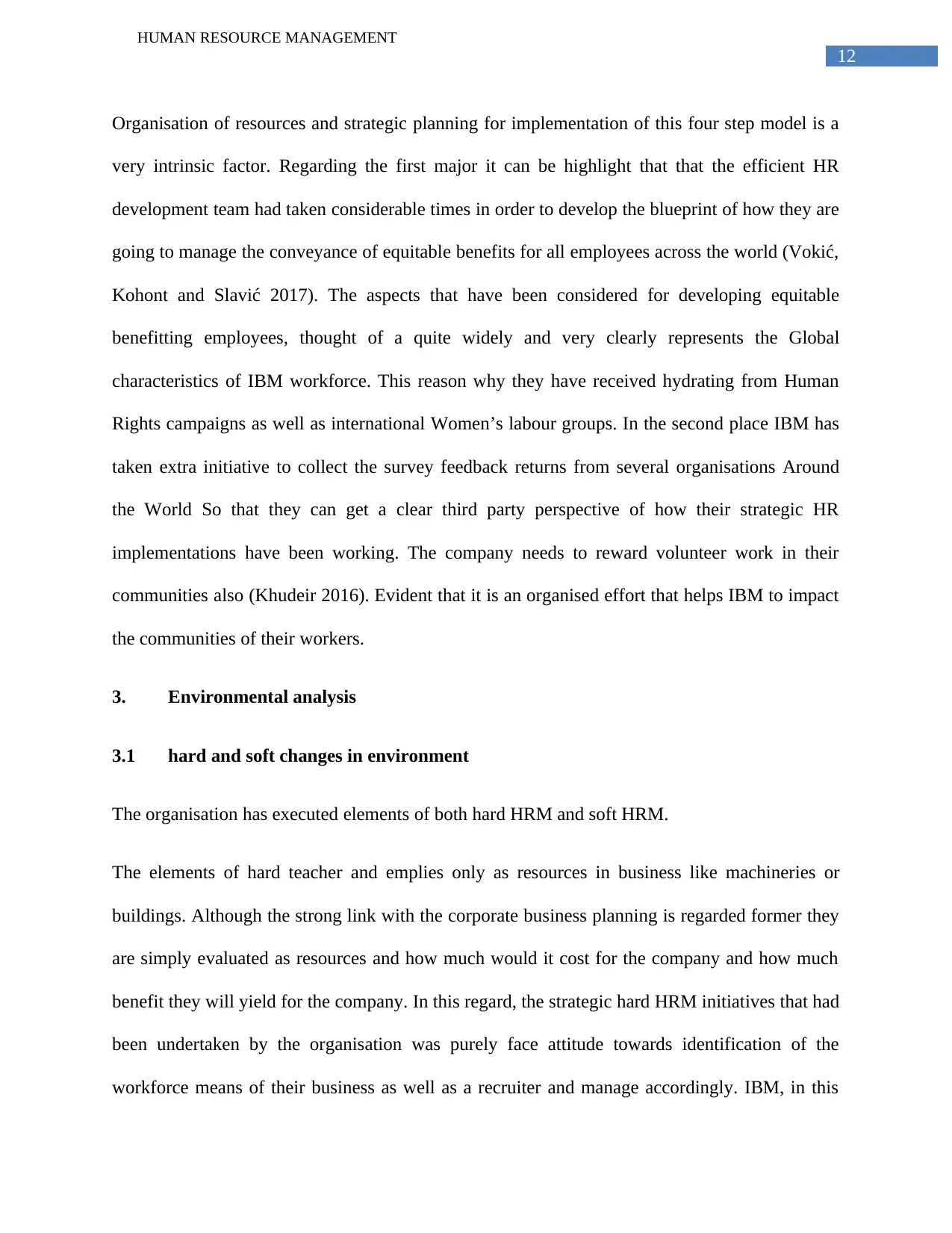
12
HUMAN RESOURCE MANAGEMENT
Organisation of resources and strategic planning for implementation of this four step model is a
very intrinsic factor. Regarding the first major it can be highlight that that the efficient HR
development team had taken considerable times in order to develop the blueprint of how they are
going to manage the conveyance of equitable benefits for all employees across the world (Vokić,
Kohont and Slavić 2017). The aspects that have been considered for developing equitable
benefitting employees, thought of a quite widely and very clearly represents the Global
characteristics of IBM workforce. This reason why they have received hydrating from Human
Rights campaigns as well as international Women’s labour groups. In the second place IBM has
taken extra initiative to collect the survey feedback returns from several organisations Around
the World So that they can get a clear third party perspective of how their strategic HR
implementations have been working. The company needs to reward volunteer work in their
communities also (Khudeir 2016). Evident that it is an organised effort that helps IBM to impact
the communities of their workers.
3. Environmental analysis
3.1 hard and soft changes in environment
The organisation has executed elements of both hard HRM and soft HRM.
The elements of hard teacher and emplies only as resources in business like machineries or
buildings. Although the strong link with the corporate business planning is regarded former they
are simply evaluated as resources and how much would it cost for the company and how much
benefit they will yield for the company. In this regard, the strategic hard HRM initiatives that had
been undertaken by the organisation was purely face attitude towards identification of the
workforce means of their business as well as a recruiter and manage accordingly. IBM, in this
HUMAN RESOURCE MANAGEMENT
Organisation of resources and strategic planning for implementation of this four step model is a
very intrinsic factor. Regarding the first major it can be highlight that that the efficient HR
development team had taken considerable times in order to develop the blueprint of how they are
going to manage the conveyance of equitable benefits for all employees across the world (Vokić,
Kohont and Slavić 2017). The aspects that have been considered for developing equitable
benefitting employees, thought of a quite widely and very clearly represents the Global
characteristics of IBM workforce. This reason why they have received hydrating from Human
Rights campaigns as well as international Women’s labour groups. In the second place IBM has
taken extra initiative to collect the survey feedback returns from several organisations Around
the World So that they can get a clear third party perspective of how their strategic HR
implementations have been working. The company needs to reward volunteer work in their
communities also (Khudeir 2016). Evident that it is an organised effort that helps IBM to impact
the communities of their workers.
3. Environmental analysis
3.1 hard and soft changes in environment
The organisation has executed elements of both hard HRM and soft HRM.
The elements of hard teacher and emplies only as resources in business like machineries or
buildings. Although the strong link with the corporate business planning is regarded former they
are simply evaluated as resources and how much would it cost for the company and how much
benefit they will yield for the company. In this regard, the strategic hard HRM initiatives that had
been undertaken by the organisation was purely face attitude towards identification of the
workforce means of their business as well as a recruiter and manage accordingly. IBM, in this
⊘ This is a preview!⊘
Do you want full access?
Subscribe today to unlock all pages.

Trusted by 1+ million students worldwide
1 out of 25
Related Documents
Your All-in-One AI-Powered Toolkit for Academic Success.
+13062052269
info@desklib.com
Available 24*7 on WhatsApp / Email
![[object Object]](/_next/static/media/star-bottom.7253800d.svg)
Unlock your academic potential
Copyright © 2020–2025 A2Z Services. All Rights Reserved. Developed and managed by ZUCOL.





